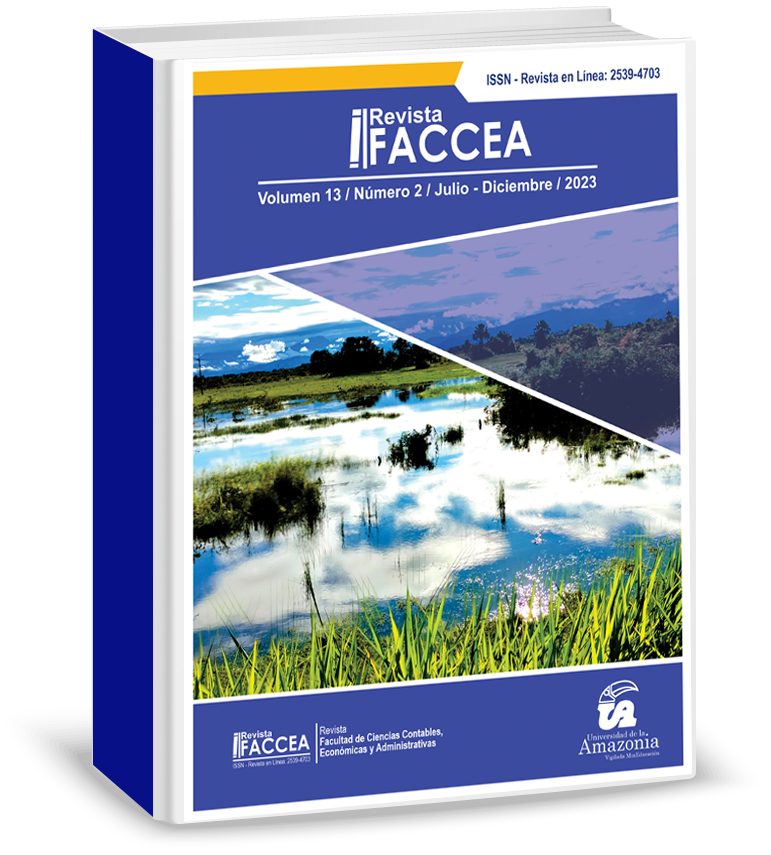PERCEPCIÓN DE ROSTROS OCLUIDOS Y SUS EFECTOS SOCIALES DESDE LA ECONOMÍA CONDUCTUAL
DOI:
https://doi.org/10.47847/faccea.v13n2a3Palabras clave:
Percepción, Mascarilla, Economía, Comportamiento, MarketingResumen
El artículo ahonda sobre un efecto poco estudiado derivado del uso de mascarillas sanitarias durante la pandemia COVID-19. Se realiza una exploración de aportes teóricos-conceptuales para identificar los sesgos cognitivos que influencian la percepción ante la presencia de este oclusor y sus posibles consecuencias en las relaciones sociales y comerciales. En este sentido, se realiza una revisión de literatura, identificando cerca de 50 documentos científicos que, brindaron información relevante para entender el tema y servir de fundamento a futuras investigaciones. Se concluye que existe una relación directa entre el uso de las mascarillas sanitarias y una mayor percepción de la belleza con una consecuente valoración social positiva en diferentes áreas que contribuyen a un mejor desempeño económico.
Descargas
Referencias
Adams, G. R. (1977). Physical attractiveness research. Human Development, 20(4), 217–239. https://doi.org/10.1159/000271558
Agthe, M., Spörrle, M., Frey, D., y Maner, J. K. (2014). Looking up versus looking down: attractiveness-based organizational biases are moderated by social comparison direction. Journal of Applied Social Psychology, 44(1), 40–45. https://doi.org/10.1111/jasp.12198
Arnheim, R. (1967). Arte y percepción visual. Psicología de la visión creadora (2a. Ed.). Buenos aires: EUDEBA.
Aydınoğlu, N. Z., y Cian, L. (2014). Show me the product, show me the model: Effect of picture type on attitudes toward advertising. Journal of Consumer Psychology, 24(4), 506–519. https://doi.org/10.1016/j.jcps.2014.04.002
Bar, M. (2003). A Cortical Mechanism for Triggering Top-Down Facilitation in Visual Object Recognition. Journal of Cognitive Neuroscience, 15(4), 600–609. https://doi.org/10.1162/089892903321662976
Barthes, R. (1986). Retórica de la imagen. In Lo obvio y lo obtuso (pp. 127–140). Buenos Aires: Paidós.
Berg, H. (2015). Faces of Marketing: Examining Consumer Responses to depictions of people in marketing. Stockholm School of Economics.
Bower, A. B., y Landreth, S. (2001). Is beauty best? Highly versus normally attractive models in advertising. Journal of Advertising, 30(1), 1–12. https://doi.org/10.1080/00913367.2001.10673627
Buunk, A. P., y Dijkstra, P. (2011). Does attractiveness sell? Women’s attitude toward a product as a function of model attractiveness, gender priming, and social comparison orientation. Psychology & Marketing, 28(9), 958–973. https://doi.org/10.1002/mar.20421
Castro Hernández, J. C. (2009). ¿Una filosofía del cuerpo en Kant?: una aproximación estético-antropológica. Praxis Filosófica, (28), 169–180.
Childers, T. L., y Houston, M. J. (1984). Conditions for a picture-superiority effect on consumer memory. Journal of Consumer Research, 11(2), 643–654. https://doi.org/10.1086/209001
Department of Labor. (2021). National census of fatal occupational injuries in 2020. Retrieved from https://www.bls.gov/news.release/pdf/cfoi.pdf
Dion, K. K., Berscheid, E., y Walster, E. C. (1972). What is beautiful is good. Journal of Personality and Social Psychology, 24(3), 285–290. https://doi.org/10.1037/h0033731
Efran, M. G. (1974). The effect of physical appearance on the judgment of guilt, interpersonal attraction, and severity of recommended punishment in a simulated jury task. Journal of Research in Personality, 8(1), 45–54. https://doi.org/10.1016/0092-6566(74)90044-0
Festinger, L. (1957). A Theory of Cognitive Dissonance. California: Stanford University Press.
Hasher, L., Goldstein, D. M., y Toppino, T. (1977). Frequency and the Conference of Referential Validity. Journal of Verbal Learning and Verbal Behavior, 16, 107–112. https://doi.org/10.1016/S0022-5371(77)80012-1
Hies, O., y Lewis, M. B. (2022). Beyond the beauty of occlusion: medical masks increase facial attractiveness more than other face coverings. Cognitive Research: Principles and Implications, 7(1). https://doi.org/10.1186/s41235-021-00351-9
Hill, C. A. (2004). The psychology of rhetorical images. In C. A. Hill & M. Helmers (Eds.), Defining visual rhetorics (pp. 25–40). Mahwah, NJ: Lawrence Erlbaum Associates.
Javid, B., Weekes, M. P., y Matheson, N. J. (2020). Covid-19: should the public wear face masks? BMJ, 369. https://doi.org/10.1136/bmj.m1442
Jones, B. C., Little, A. C., Burt, D. M., y Perrett, D. I. (2004). When facial attractiveness is only skin deep. Perception, 33(5), 569– 576. https://doi.org/10.1068/p3463
Kamatani, M., Ito, M., Miyazaki, Y., y Kawahara, J. I. (2021). Effects of masks worn to protect against COVID-19 on the perception of facial attractiveness. I-Perception, 12(3), 1–14. https://doi.org/10.1177/20416695211027920
Kant, E. (1991). Antropología en Sentido Pragmático. Madrid: Alianza.
Klebl, C., Luo, Y., Tan, N. P., Ping Ern, J. T., y Bastian, B. (2021). Beauty of the Beast: Beauty as an important dimension in the moral standing of animals. Journal of Environmental Psychology, 75, 101624. https://doi.org/10.1016/j.jenvp.2021.101624
Lawrence, D. H. (2012). El amante de lady Chatterley. Madrid: Alianza.
Lynch, J., y Schuler, D. (1994). The matchup effect of spokesperson and product congruency: A schema theory interpretation. Psychology & Marketing, 11(5), 417–445. https://doi.org/10.1002/mar.4220110502
Maestripieri, D., Henry, A., y Nickels, N. (2017). Explaining financial and prosocial biases in favor of attractive people: Interdisciplinary perspectives from economics, social psychology, and evolutionary psychology. Behavioral and Brain Sciences, 40. https://doi.org/10.1017/S0140525X16000340
Martínez, D., Rojas, A. M., y Scartascini, C. (2020). La economía del comportamiento puede ayudar a combatir el coronavirus. Banco Interamericano de Desarrollo.
McQuarrie, E. F. (2007). Differentiating the pictorial element in advertising: A rhetorical perspective. New York: Laurence Erlbaum Associates.
Menéndez-Pidal, S. N. (2010). Retórica visual: una herramienta necesaria en la creación e interpretación de productos visuales. Revista de Artes y Humanidades UNICA, 11(2), 99–116.
Milgram, S. (1963). Behavioral Study of obedience. The Journal of Abnormal and Social Psychology, 67(4), 371–378. https://doi.org/10.1037/h0040525
Milgram, S. (1976). The image-freezing machine. Society, 14(1), 7–12.
Miyazaki, Y., y Kawahara, J. I. (2016). The sanitary-mask effect on perceived facial attractiveness. Japanese Psychological Research, 58(3), 261–272. https://doi.org/10.1177/20416695211027920
Montepare, J. M. (2010). “Cue, vue, action”: An ecological approach to person perception. In Social psychology of visual perception (pp. 299–323). New York: Psychology Press. https://doi.org/10.4324/9780203848043
Navarro, C., y Villanueva, J. (2011). Proporciones del equilibrio facial. El acondicionamiento seguro y sencillo de supraestructuras de implante. Quitessence Técnica, 22(2), 1–95.
Nelson, D. L., Reed, V. S., y Walling, J. R. (1976). Pictorial superiority effect. Journal of Experimental Psychology, 2(5), 523–528. https://doi.org/10.1037/0278-7393.2.5.523
Organización Panamericana de la Salud. (2020). La OMS caracteriza a COVID-19 como una pandemia. Retrieved from https://www.paho.org/es/noticias/11-3-2020-oms-caracteriza-covid-19-como-pandemia
Patel, V., Mazzaferro, D. M., Sarwer, D. B., y Bartlett, S. P. (2020). Beauty and the Mask. Plastic and reconstructive surgery. Global Open, 8(8), e3048. https://doi.org/10.1097/GOX.0000000000003048
Peracchio, L. A., y Meyers-Levy, J. (1994). How ambiguous cropped objects in ad photos can affect product evaluations. Journal of Consumer Research, 21(1), 190–204. https://doi.org/10.1086/209392
Peracchio, L. A., y Meyers-Levy, J. (2005). Using stylistic properties of ad pictures to communicate with consumers. Journal of Consumer Research, 32(1), 29–40. https://doi.org/10.1086/429599
Plous, S. (1993). The Psychology of Judgment and Decision Making. New York: McGraw-Hill.
Pugh, S. D. (2001). Service with a smile: Emotional contagion in the service encounter. Academy of Management Journal, 44(5), 1018–1027. https://doi.org/10.2307/3069445
Ramírez-Ortiz, J., Castro-Quintero, D., Lerma-Córdoba, C., Yela-Ceballos, F., y Escobar-Córdoba, F. (2020). Mental health consequences of the COVID-19 pandemic associated with social isolation. Colombian Journal of Anestesiology, 48(4). https://doi.org/10.5554/22562087.e930
Sadr, J., y Krowicki, L. (2019). Face perception loves a challenge: Less information sparks more attraction. Vision Research, 157, 61–83. https://doi.org/10.1016/j.visres.2019.01.009
Scott, L. M. (1994). Images in advertising: The need for a theory of visual rhetoric. Journal of Consumer Research, 21(2), 252–273. https://doi.org/10.1086/209396
Secord, P. F. (1958). Facial features and inference processes in interpersonal perception. In Person Perception and Interpersonal Behavior (pp. 300–315). Stanford, CA: Stanford University Press.
Sekuler, A. B. (1994). Local and global minima in visual completion: effects of symmetry and orientation. Perception, 23(5), 529–545. https://doi.org/10.1068/p230529
Simon, H. (1955). A behavioral model of rational choice. The Quarterly Journal of Economics, 69(1), 99–118. https://doi.org/10.2307/1884852
Söderlund, M., y Lange, F. (2006). Visual persuasion with physically attractive models in ads: An examination of how the ad model influences product evaluations. SSE/EFI Working Paper Series in Business Administration. Retrieved from https://ideas.repec.org/p/hhb/hastba/2006_008.html
Söderlund, M., y Rosengren, S. (2010). The happy versus unhappy service worker in the service encounter: Assessing the impact on customer satisfaction. Journal of Retailing and Consumer Services, 17(2), 161–169. https://doi.org/10.1016/j.jretconser.2010.01.001
Stefanidis, D., Nicolaou, N., Charitonos, S. P., Pallis, G., y Dikaiakos, M. (2022). What’s in a face? Facial appearance associated with emergence but not success in entrepreneurship. The Leadership Quarterly, 33(2). https://doi.org/10.1016/j.leaqua.2021.101597
Thorndike, E. L. (1920). A constant error in psychological ratings. Journal of Applied Psychology, 4(1), 25–29. https://doi.org/10.1037/h0071663
Townsend, C., y Kahn, B. E. (2014). The “visual preference heuristic”: the influence of visual versus verbal depiction on assortment processing, perceived variety, and choice overload. Journal of Consumer Research, 40(5), 993–1015. https://doi.org/10.1086/673521
Tversky, A., y Kahneman, D. (1973). Availability: A heuristic for judging frequency and probability. Cognitive Psychology, 5(2), 207–232. https://doi.org/10.1016/0010-0285(73)90033-9
Ullman, S. (1995). Sequence seeking and counter streams: a computational model for bidirectional information flow in the visual cortex. Cerebral Cortex, 5(1), 1–11. https://doi.org/10.1093/cercor/5.1.1
Vega, E. (2013). Joseph Goebbels: Una mentira mil veces dicha, se convierte en una gran verdad. Universidad Rey Juan Carlos.
Wedel, M., y Pieters, R. (2007). Introduction to visual marketing. New York: Laurence Erlbaum Associates.
Willis, J., y Todorov, A. (2006). First impressions: making up your mind after a 100-ms exposure to a face. Psychological Science, 17(7), 592–598. https://doi.org/10.1111/j.1467-9280.2006.01750.x
Zebrowitz, L. A. (1997). Reading Faces: Window to the Soul? (1st ed.). New York: Routledge. https://doi.org/10.4324/9780429493188
Descargas
Publicado
Número
Sección
Licencia
Derechos de autor 2023 Revista Facultad de Ciencias Contables Económicas y Administrativas -FACCEA

Esta obra está bajo una licencia internacional Creative Commons Atribución-NoComercial-CompartirIgual 4.0.



















